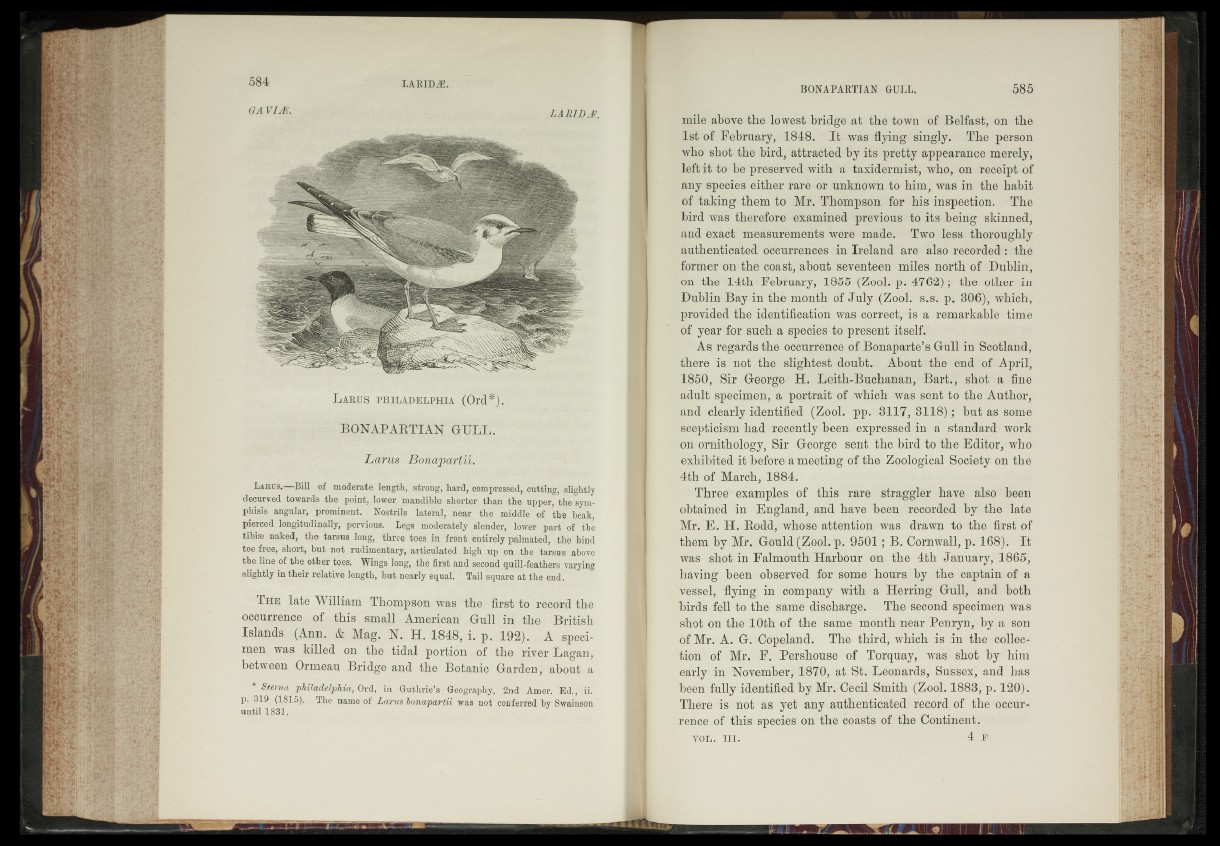
Larus Philadelphia, j(6rd^j.
BONAPARtlAN GtTLL.
Larks' ‘Bohtifidv%v&^
L&ats.—Bill | of moderate - letfgiii, ; strong, hardcompresied, SuUmg, -Slightly
deewved towards the poi^_ lower shorief .than Jhe .u^per, % symphisis
angular, prominent."" jN6stii^i;ia ^® ,|n e a r ' the m id d l^ T the beak,
pierced longitudin‘ally, pervious. Legs modmately,-Jsle?der,'lower part .of’t t e
tibiae naked, the tarsus long,- -three'toes- in front- en tire ty ^ Ird a te a ^S ’e' ifjffiL
toe free, short, but -not rudimentary, articulated high np the tarsus a-bo^e
the line of Hie other toes. Wings long, the feat and^cgncj. quill-feathers varying
slightly in their,relative lengthrbut nearly equal. Tail square a t ^ e ^ S .
The f|te William T-hqnapfc/M| was'4fee dirst-to'record the
oe£.q£renc§^f this- small American GuR'T&f tk e ' -British
Islands (Ann. & Mag. H. 1848,; i. p. 192f>*.; .A£;spjeci-
men was killedr\Qji- the tidal '‘portion - of the > river Lagan,
between Ormeau Bridge and the? Botanic Garden, about a
Sterna Philadelphia, ©rd, ’in Guthrie’s Geography, Amer. Ed., ||jSv
p. ,319 The name .of Larus bonapartii was not "conferred by Swainson
until. 13.31. „
mile Above the lowest bridge at the town of Belfast, on the
1 st of February, 1848. It was flying singly. The person
wK6 shot the bird, attracted by its pretty appearance merely,
left it to be preserved with *a taxidermist, who, on receipt of
any species either rare or unknown to him, was in the habit
of taking them to Mr. Thompson for bis inspection.’ -The
bird was therefore-examined previous to-its being skinned,
and exact -measurements were made. Two less: thoroughly
authenticated’ occurrences in Ireland| are • also recorded':, the
forme-rién4hè Jcoast, about seventeen miles north of Dublin,
on the 4f4t-h' February, 1855 (Zo.qlk - pA4f 62'); the other in
Dublin Bay incite month of July (Zookfus.s. p. 8§jS^| which,
'provided the identification was correct,- is a remarkabfe time
, óf year for .such a species-to ^present itself:
'" As regards-the occurrence of Bonapartë’s Gull in Scotland,
there'i# not the--slightest'bonht. Ahoutithe -end of April,
1850, Sir'George' H.'Leith-Buchanan, Bart., shot a fine
adult - specimehf-'a portrait-Jwliich' was -seht to the Author;
•and clearly identified (Zool. pp. lÉbM, 8118|?j but as somé
?Iëepticisïü had recentlysheen expressed in a standard^ work
onlóMitboTogy, Sir séntuthé bird to the Editor,«whc
ekhiKited’-it^before -a meeting of the' Zoological Society on the
4th of--March, -1884.
^Ehree* examples of this rare straggler have also'' been
öhtai-ned in England; and have-'been-.'recorded^ by the late
Mr. E.TfeRodd, whose attention was drawn to the. first of
them by Mr. Gould’(ZboIvp: 9501; B. Cornwall; -p. 16'8^i*It
was shotrih Pafmluth Harbour on the 4th January;;4-86l5;
haying been' observed for some hours by.'-fhe- captain of a
p®sel, flying in company with a Herring Gull, and both
birds fell'fo the same discharge. f> The second specimen was
;!fc)t on the 10th of the same month near Penryn;d>y-a son
Af Mr.'rA. G. Copeland. The third*, whichris in the collection
of Mr. F. iBdfkhonse of Torquay, was shot by &kn
early in November, 1-870, attSt. Leonards, Sussex- and has
héén fully;identified by Mr. Cecil Smith (Zool. 1883, p. 120).
Ifegêre as -mét as- yet any authenticated- recprd of flte epccur*
rfM’ce of’this species on the coasts of the Continents#
W . h i . 4 f .